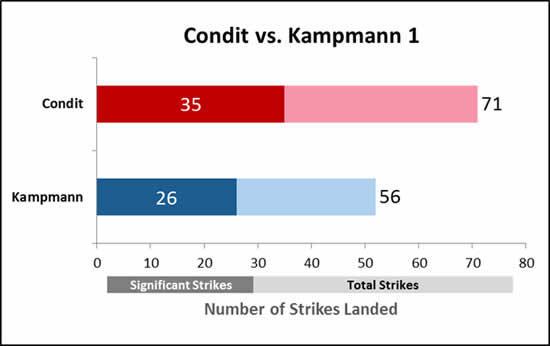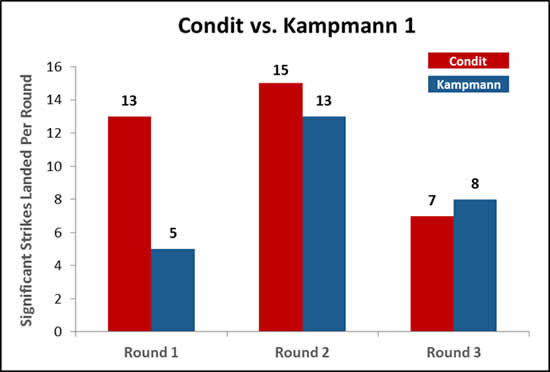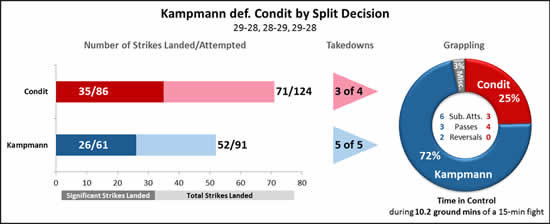At UFC Night 27, #2 ranked Carlos Condit will rematch #6 ranked Martin Kampmann for the right to remain in the title mix at welterweight. Condit has already held the interim belt and fought higher ranked opponents than Kampmann recently, despite the fact that Condit lost his first fight against Kampmann. Perhaps for this reason Condit is currently the clear betting favorite at -250, and Kampmann the underdog at +210. The UFC recently made their first fight publicly available, a back and forth grappling match that resulted in a split decision win for Kampmann, and a fairly noticeable chorus of boos at the announced decision. Here are the basic “box score” stats from FightMetric for that fight.
It shows that Condit was more active overall, and also landed more damaging strikes. On the ground both fighters were active and had opportunities, but neither finished the fight. At the end of 15 minutes, Kampmann’s battered face belied the split decision in his favor. Now let’s take a more visual look at those fight stats. Here are the Significant and Total Strikes landed for each fighter throughout the fight.
According to this look, Condit was more active and landed more strikes overall, but judges don’t score the entire fight when it ends; they have to record a score for each fighter, each round. So here’s a look at each fighter’s Significant Strikes Landed on a round by round basis.
Both graphs seem to indicate Condit landed more damage than Kampmann. According to the three-round 10-point must system, despite a close fight the numbers hint at Condit winning two rounds. That’s enough to edge out a close fight. Remembering every fight in detail is impossible. But, I was in the arena in Nashville that night in 2009 and I do remember the surprise when the decision that Kampmann had won was announced. So after running these numbers I then rewatched the fight, wondering if I would learn something about how judges render their decisions and how box scores might be misleading. So after re-watching the video of that fight, the biggest thing to factor in is that the fight actually spends the majority of the time on the ground. Out of 15 minutes of fight time, over 10 of those minutes were on the mat. Both fighters got takedowns, advanced position, and went for submissions, but neither was able to finish. Arguably, Kampmann was saved from a choke by the final bell, but the rest of the fight, he was usually in control. However, at the end of each round I was left with the impression that Condit was the more dangerous of the two. It’s clear from the standup exchanges that Condit landed the more damaging blows, and throughout the fight he appeared more active attempting and landing strikes. He survived the submission attempts, and was active fighting off his back. So what’s the deal? How do two out of three judges award the fight to Kampmann? The answer lies in a subtlety of the Unified Rules of MMA. Down in section 14 entitled “Judging,” the following caveat is placed: A. Judges shall use a sliding scale and recognize the length of time the fighters are either standing or on the ground, as follows: I. if the mixed martial artists spent a majority of a round on the canvas, then: a. Effective grappling is weighed first; and b. Effective striking is then weighed II. If the mixed martial artists spent a majority of a round standing, then: a. Effective striking is weighed first; and b. Effective grappling is then weighed Knowing that this fight was supposed to be judged based on grappling first, then striking second, we should take a different look at the stats from the fight. Consider this new view that also accounts for takedowns, ground control time, and also submission attempts, guard passes, and position reversals (sweeps).
Now, the picture is clearer. Kampmann was five for five on takedowns, which resulted in him spending the lion’s share of time in top control. Despite not finishing the fight, he went for a submission six times and even swept position on Condit twice when Condit had gained control. Because most of the fight was spent on the ground, the Unified Rules dictate that judges evaluate the grappling aspect of the fight first before considering standup striking. The result is that judges awarded more rounds to Kampmann for his ground control by prioritizing that above overall striking output, which wasn’t skewed enough towards Condit to alter the decision. The lesson here is that reading the fine print can be important. Plenty of judges’ decisions have left people scratching their heads. But there is a method to their madness, and understanding the guidelines they are attempting to follow is important in understanding how fights went a certain way, and even in predicting how certain matchups will be interpreted on the judges’ cards. While stealing rounds with a single late takedown should not be possible, using lengthy top control to grind out victory is certainly consistent with the scoring rules. Carlos Condit was an interim champion. He has excellent range, uses lots of combinations, and has defeated formidable strikers. But in each of his recent losses, as well as his loss to Kampmann, he was put on his back over and over again. His takedown defense metric is currently running below average for his peers. That’s been a critical ingredient in understanding his fights. When he faced guys that tried to put him on his back, he lost. Now Condit faces Kampmann for a second time, hopefully with a re-engineered takedown defense. We’ll have to watch to see how things play out, but at least now we know what judges will be using to frame their scoring decisions should the fight spend more time on the ground than standing. And when evaluating future matchups, there’s a difference in striking and grappling skills, it’s important to consider takedown offense and defense as a clue as to where the fight will end up.



